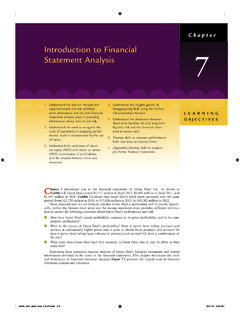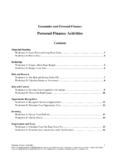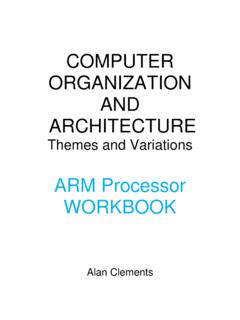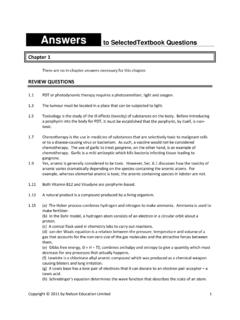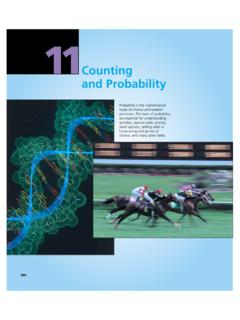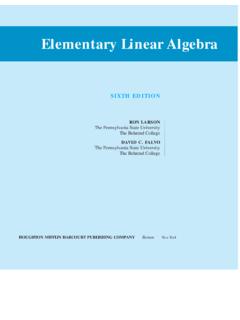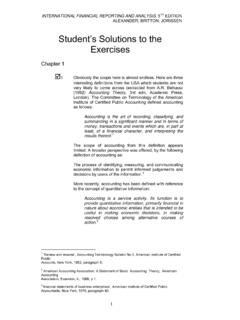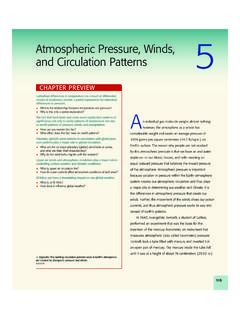Transcription of CHAPTER 23 Alarm Event Programming - Cengage
1 CHAPTER 23 Alarm & Event Programming Objectives After completing this CHAPTER , you should have the knowledge to: Understand Alarm Programming . Apply the various techniques to capture Alarm and Event information. Many PLC applications require some form of alarming when abnormal conditions or events occur. PLCs are well suited for this task and in fact, many PLC manufacturers provide special instructions designed just for this purpose. Some of these special instructions will be covered later in this CHAPTER . Alerting operating or maintenance personnel of abnormal conditions or problems saves time and increases machine or process up time. When detailed alarming is provided, many problems can be resolved by operators themselves rather than calling a technician to find the problem saving time and increasing productivity.
2 When a PLC system is connected to one of the many HMI interfaces available on the market today, the HMI can provide all of the alarming functions necessary with minimal additional PLC Programming . Most HMI software packages provide some form of alarming and Event recording. These HMI systems continually monitor the PLC s internal data files or tags and based on how the HMI is programmed will Alarm accordingly. When HMI interfaces with built in alarming features are not part of the overall system or when events must be captured faster than an HMI system can monitor, the alarming and Event recording must be programmed in the PLC. This CHAPTER is dedicated to showing the reader some of the techniques and instructions used to program Alarm and Event information in PLCs. BASIC Alarm LOGIC Alarms and events can be triggered from digital information such as a motor failing to start or run.
3 They can be triggered from process analog values such as a high temperature or low pressure. Whether monitoring a digital or analog value the end result is the same, a bit or tag is typically set to a 1 or ON indicating that a problem has been detected. Figure 23 1 illustrates an example of this basic logic. RanananwmAfswthfrotA reprBobeung 1 in Figurn Alarm if thenalog tempern internal bit with an actual monitored by after studying witch is turneherefore the mraction of a sether PLC logicsimilar probleached 101 frocess, the opoth problemselow in Figurere 23 1 monite motor is notrature input (or tag that, woutput that ian HMI interfRung 1 in Figed ON, the stamotor Alarm econd may noc that uses thlem can be sefor only a spliperator may ns described abe 23 2. Figutors the motot running wheN7:1) and alawhen ON, indilluminates a face system.
4 Gure 23 1, youatus input frowill be ON foot seem like mis Alarm inforeen in the sect second causnot know whbove can be cre 23 1 Basic or on/off switen the switch arms if the teicates an abnlight, sounds u should see am the motor r a fraction omuch but it carmation or facond rung witsing the high at happenedcorrected witAlarm Logic tch and correis in the ON mperature exnormal condita horn, or lefa basic problestarter does f a second asan trigger falslsely turning th the over tetemperature. h some simpExample sponding moposition. Thexceeds 100 Ftion. This inteft as an internem with this anot change ss the motor cose alarms thaon an Alarm oemperature ae Alarm to turle changes tootor starter ste second rungF. In both runernal bit or tanal memory aalarm logic. Wstate immediaontactor chant can cause poutput.
5 Larm. If the tern ON shuttino the Alarm lo tatus input tog monitors angs the outputg can be repladdress that iWhen the moately and nges state. Thproblems withemperature g down the ogic as shown set n t is aced is otor his h InalThexthacabCCacimthth n the first runlarm is activahe second runxample we hahe Alarm set pction. See Chbnormal motCAPTURING apturing and rcuit as was smeaning the ahe Alarm retehis CHAPTER . g an On Delated which is eng uses a seaave used the point before thapter 22 for or conditionsG Alarm Eretaining alashown in Figularm status wntive as showFigury Timer (TONenough time ling circuit tostart push buthe Alarm canan example os. events rm informatioure 23 2, Rungwill be lost if twn in Figure 2re 23 2 EnhanN) has been adfor the motoo seal in the autton as the rn be reset. Thof a motor fauon can be dog 2 and somehe processor23 3.
6 Other mnced Basic Aladded that allor contactor toalarm until theeset start buttoult and monitne in multiplee means to rer loses powermethods, sucharm Logic ows for a smao change state Alarm is res. Of course, ton can be reptoring logic the ways. A simest the Alarm .. Latching ins as moving daall delay befote and prevenset by the opehe temperatuplaced with alhat can be usemple method i This methodstructions canata, will be dore the motornt a false alarerator. In ourure must be bmost any desed to Alarm is to use a sead is non retenn be used to miscussed later r rm. r below sired aling ntive, make r in YoThpuASoramtochanchincutialou will noticehis is done toushed while tANALOG RAome applicatiapid rate of chmove, and bit o the evaluatihanging the tnalog value (Fhange is storenstruction andurrent analogmer is done.)
7 Larm on a dece in Figure 23 o ensure that the Alarm is sATE OF CHions require thange and alainstructions tion period (30imer preset vF8:1) that waed in F8:2 andd requires a cg value when This logic mocreasing rate Fi 3 that the alathe Alarm remtill active. HANGE ALAthat analog vaarm if such a to create a ra0 seconds). Thvalue. Rung 4 s stored at thd can be chancorrespondingthe PLC is firsonitors for a pof change or igure 23 3 Latarm reset (unmains set for ARM LOGI alues such ascondition exite of change his evaluationcompares thhe end of the nged to any dg unlatch instst started so tpositive (increboth if desiretching Alarm nlatch) rung isthe entire PLC temperatureists. The logicalarm. Rung n period can e current analast evaluatioesired value. truction to resthat a false aleasing) rate ofed. Logic s located aboLC program sce, pressure, lec in Figure 23 2 in Figure 23be set to anyalog value stoon period.
8 Th The Alarm oset the alarmlarm is not gef change, whove the alarmcan if the starevel, etc. be m 4 uses a time3 4 is a free ry desired valuored in F8:0 we maximum aoutput is latchm. Rung 1 is usenerated the ich can be ea set (latch) rurt button is monitored forer, compare, unning timere by simply with the previallowable rathed using the sed to store tfirst time theasily changed ung. r a set ious e of latch the e to Figur e 23 4 Rate oof Change Alaarm Logic AEaboenanyewdehaThtedeexThanboANNUNCIA arly alarming oards used a ngraved on thnnunciators wet acknowledwas acknowledepending on ad occurred (he PLC ladderemperature aescribed abovxample on hohe over tempn internal meoard. ATOR LOGIC methods uselight behind ahe window. Wwould use thrged by the opdged, the alarthe state of t(flashing), whr logic to mimalarm as was sve.)
9 The Flasow to programperature alarmemory addresC ed an annuncan opaque wWhen the alarree modes to perator, the arm window wthe Alarm . Opich are still acmic the early ashown in Figusher contact m this flasherFigurem could be a s monitored iator board toindow. The orm was activeindicate an aalarm windowwould stop flaperators couldctive (illuminannunciators ure 23 2 and ais a secondr. e 23 5 Basic Ahardwired ouby an HMI tho notify operpaque windoe the windowalarm conditiow would flashashing and eitd monitor theated), and whis shown Figuadded the ned On/Off inteAnnunciator Tutput to a lighat has been pators of probow would havw would be illuon. If the alah indicating thther remain ile annunciatorhich were noture 23 5. Herecessary logicrnal memoryType Logic ht on an annuprogrammed blems. These ave the name ouminated.
10 Thrm had been he problem. Olluminated orr board and tet active (non re we have usc so that the ay address. Seeunciators boato mimic an annunciator of the Alarm hese Alarm triggered buOnce the alarr turn off ell which alar illuminated).sed the same Alarm functioe CHAPTER 22 frd or it couldannunciator t not m rms . over ns as for an be If BbewyoatChInwhuwThThshyou only havut if you haveecome cumbway to handle ou recall fromt the bit levelhapter 6 woun the examplewords of of alword, file, andhe first step i Word Word unackn Word Word still ache second stehown in Figurve a handful oe more than aersome requia large numbm CHAPTER 6 to make logiuld be strongle that follows Later in this arms at one t bitwise opers to create fo1 (N7:0) Raw2 (N7:1) Currnowledged. 3 (N7:2) Ackn4 (N7:3) Unactive. ep is to progrre 23 6.
